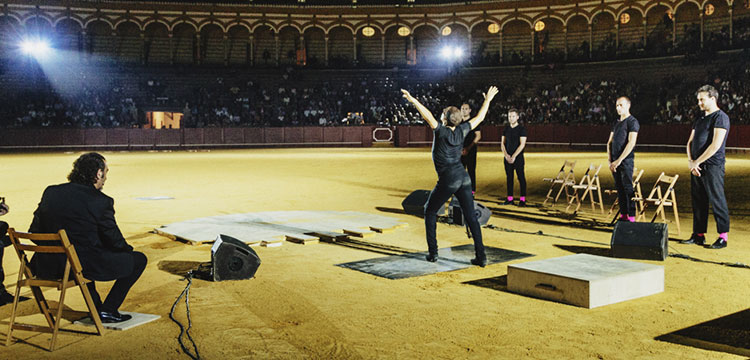The updated version of Arena with which Israel Galván opened the Bienal at the bull-ring leaves a bittersweet taste
“Arena”. Artistic director: Israel Galván and Pedro G. Romero. Choreography and dance: Israel Galván. Voice: David Lagos, Jesús Méndez, Kiki Morente and Niño de Elche. Guitar: Alfredo Lagos. Percussion: Antonio Moreno (Proyecto Lorca). Percussion quartet: Agustín Jiménez, Darío Valecillo, Eugenio García and Gilles Midoux. Rhythm and chorus: Los Mellis. Saxophone and gaita del Gastor: Juan M. Jiménez (Proyecto Lorca). Piano: Sylvie Courvoisier. Band: Charanga Los Sones. Bienal de Sevilla. Plaza de Toros. Friday, September 7th, 2018. One third attendance.
Sara Arguijo
The warm voice of Kiki Morente announces each bull from the stands…his sound makes us recollect…
BULL NO. 1. Bailador (for Joselito el Gallo, 1920). Boredom. While my eyes follow Israel Galván, I ask myself if that which impressed me from Arena, will continue to do so fourteen years later, and if those pieces that remained in my retina will have the same effect in such an imposing venue. A round of verdiales, malagueñas, rondeñas…enough to recreate the death of Belmonte. All from one angle of the bull-ring. There’s too much empty space, and we wait for some sort of impact. More provocation.
BULL NO. 2. Granaíno (for Ignacio Sánchez Mejías, 1934). Confusion. Galván is in the center of the arena and bull-fights the Llanto a la Muerte de Ignacio Sánchez Mejías with a sort of rocking-chair, with the music of Antonio Moreno and the percussion section of the Joven Orquesta de Andalucía. I like the way the Seville dancer plays with it, and sticks his leg up to the hilt. I admire the hypnotic capacity of his dancing in this register but of course, I’ve been witness to the impressive artistic growth of this interpreter over the years, and I’m no longer the least surprised by this. Repetetive and monotonous I jot down.
BULL NO. 3. Pocapena (for Manuel Granero, 1922). Enthusiasm. Israel pulls from his memory the flamenco he grew up with, and dispenses the first flashes of noticeable genius. Alegrías of Cádiz starts to soak through his bones, his skin and his muscles, and we see a unique artist who seems to take dance as a continuous quest. This is the best part of the night.
David Lagos does such a fine job with his vendor’s song about mint candy, the audience applauds enthusiastically, and I feel the urge to dig some coins out of my purse!
BULL NO. 4. Burlero (for José Cubero Sánchez, Yiyo, 1985). Depth. Jesús Méndez and the Mellis bring the Jerez sound and the bull-ring fills with “oles” upon seeing the Seville man get carried away with this three-quarter time. At this point, after more than an hour and a half of show, and with my legs numb due to the narrow stands, we were in need of some passion and energy.
BULL NO. 5. Playero (for Manuel Montaño, 1905). Senseless. Niño de Elche begins an impossible recital with tales of horror, and I ask myself: why does Israel want to punish us like this? Once again lack of enthusiasm is upon us. Pianist Sylvie Courvoisier leaves by the back door and the man from Elche begins an unbearable string of guttural sounds that once again break the pacing of the work.
BULL NO. 6 (for José Rodríguez Davié, Pepete, 1899). Rejoicing. Sharp blades project from Galván’s dance boots, and we remember as if it were yesterday how much of an impact that had in its day. Amazing how much this artist has given flamenco and art in general, and how much we have to thank him for! Despite the fact that here the large space worked against him and made the endeavor tedious.
ENDING. Pasodoble music, marches and even Paquito el Chocolatero sound. Finally, a break. The artist drags himself across the arena and raises dust for the first time, inviting us to the tragic-comedy of the party. Little steps with much hullaballoo and the spectators pull out their white hankies to show they are leaving with a good feeling because Seville understands Israel, the people love him and value him. It’s the exception even for those who normally accept nothing that departs from the conventional. Because of his intelligence, his personality and his pranks.
But in fact, in this reworking of Arena the pacing was off and the static staging constantly left too many empty spaces. Perhaps we were expecting Galván to incorporate everything that’s happened in it since it’s debut, which is why we missed more grounding, more movement, more play, more risk-taking, more craziness, more sand…and, of course, more emotion, as there was little or none. Perhaps too, memory played tricks on us and we were invaded by cursed melancholy and were too aware of those absent, beginning with Enrique with whose video we would have been happy. Perhaps time was working against us.
Photos: Óscar Romero – La Bienal
